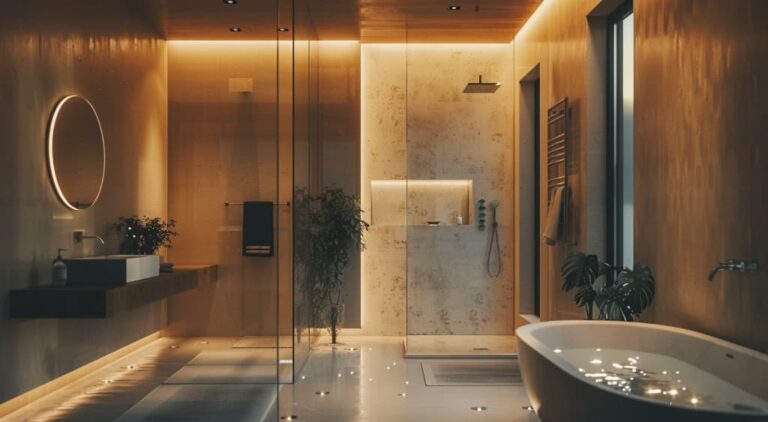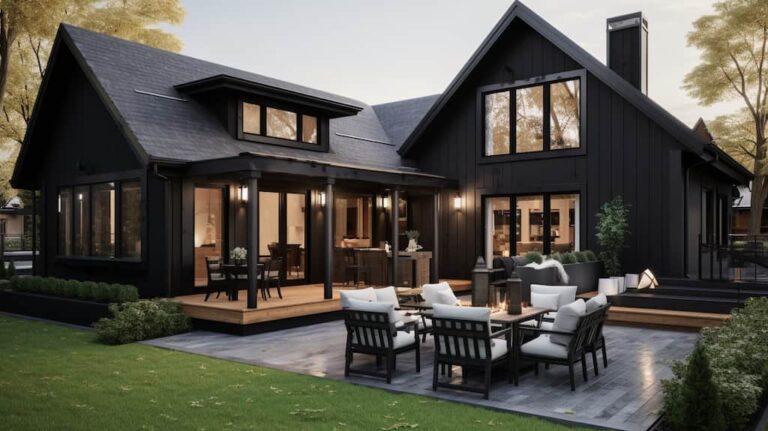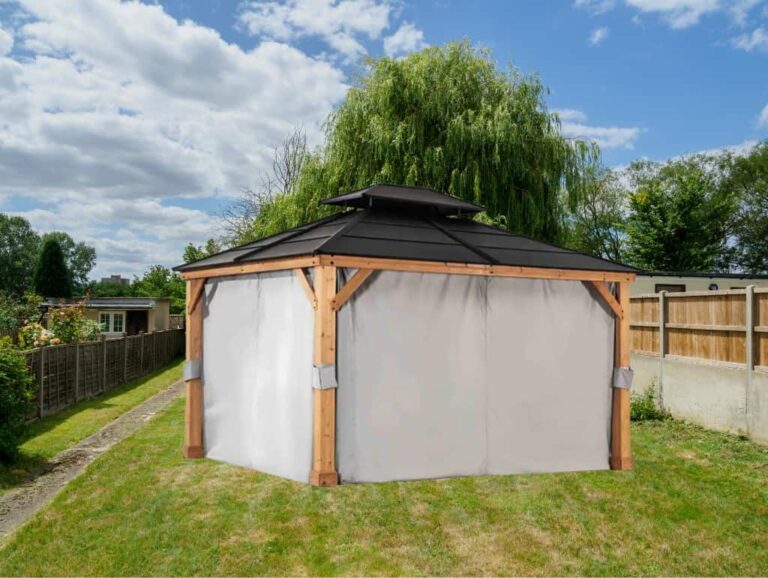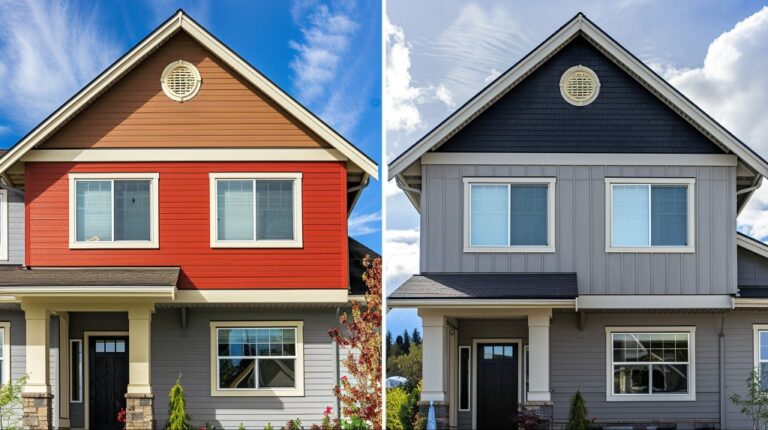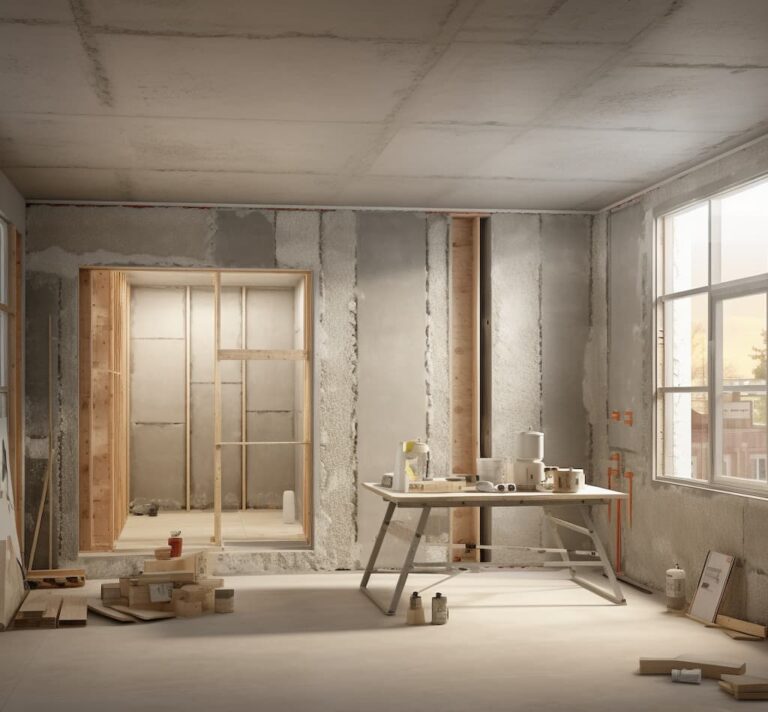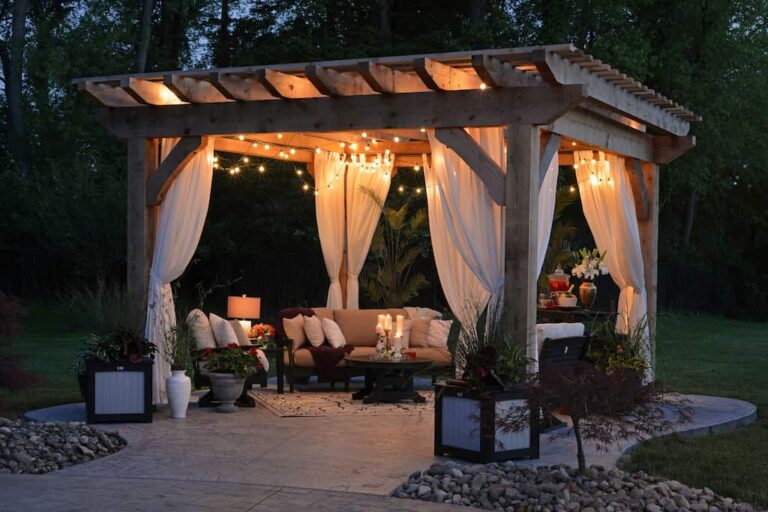5 Best Advantages and Drawbacks of Concrete Siding
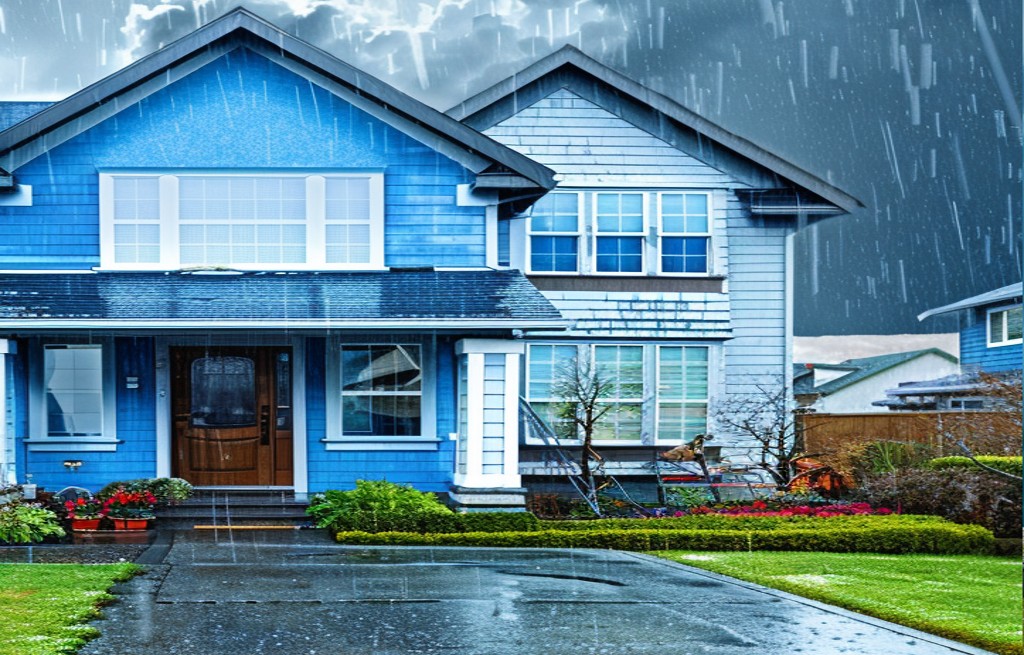
As you consider upgrading your home’s exterior, you’ve likely come across fiber cement siding, a material known for its durability and aesthetic versatility. You’ll find it’s resistant to many common hazards, including fire and termites, which certainly adds peace of mind. However, it has its downsides; the installation can be cumbersome, and the costs upfront might make you think twice. While the benefits might outweigh the negatives initially, the decision could be more straightforward. Let’s explore further why this material could be both a boon and a bane for your housing project.
What Is Fiber Cement Siding?
Fiber cement siding is a building material composed of cement, silica (sand), and cellulose fibers, often recycled. This composition is formed into boards or shingles and is used primarily for cladding the exterior of buildings. Its popularity is partly due to its resilience; it’s highly durable and resistant to fire, termites, rot, and warping, making it a long-lasting option for home siding.
However, the production of fiber cement siding isn’t without environmental impact. The process is energy-intensive and involves carbon dioxide emission, a known greenhouse gas. According to the Environmental Protection Agency, the manufacture of cement, which is a key component of fiber cement siding, is one of the largest sources of industrial CO2 emissions, contributing substantially to global greenhouse gas emissions.
Despite these environmental costs, the longevity of fiber cement siding can be seen as a benefit. Because it doesn’t require frequent replacement, less waste is generated over a building’s lifespan than materials that need more regular replacement or maintenance. This aspect, combined with the possibility of incorporating recycled materials into the fiber cement, can mitigate some of the negative environmental impacts of its production.
When selecting siding, homeowners must consider various factors, including environmental impact, durability, maintenance, and aesthetics. Fiber cement siding offers a variety of aesthetic options as it can be manufactured in different textures and colors and come pre-painted or painted after installation. This versatility allows homeowners to achieve a desired look while benefiting from the material’s practical properties.
Benefits of Fiber Cement Siding
Fiber cement siding, often underestimated, offers significant durability, potentially exceeding 50 years with minimal maintenance. This longevity makes it an excellent choice for homeowners seeking a durable home solution. According to a National Association of Home Builders study, fiber cement siding is one of the most durable forms of siding available today.
In addition to its robust nature, fiber cement siding is highly resistant to common environmental threats. It’s impervious to rot, fire-resistant, and can withstand severe weather conditions, helping to ensure the structural integrity of a home under various circumstances. The Portland Cement Association notes that the fire-resistant properties of fiber cement siding come from its composition, mainly consisting of Portland cement, sand, and cellulose fibers, which are inherently non-combustible.
The siding also boasts low maintenance requirements. It doesn’t attract pests like termites or carpenter ants, nor is it susceptible to bird damage, as they can’t digest the material. This inedibility for pests contributes significantly to its minimal maintenance, leading to cost savings over time by reducing the need for frequent repairs or replacements.
Furthermore, installing fiber cement siding can enhance a property’s value. It not only increases the safety and security of the home but also boosts its aesthetic appeal and potential market value. Adding fiber cement siding can be particularly appealing to prospective buyers, as noted in various real estate studies mention that upgraded exterior features such as durable and attractive siding can significantly impact home valuation.
Drawbacks of Fiber Cement Siding
While the benefits of fiber cement siding are well-documented, it’s crucial also to consider its disadvantages. These drawbacks could influence your decision, particularly if you weigh durability and visual appeal against other factors.
Here are the primary disadvantages to consider:
- Upfront Cost Fiber cement siding is generally more expensive initially than other siding materials such as vinyl or aluminum. This higher cost can be a significant financial consideration, especially for those unprepared for the initial investment.
- Maintenance Although fiber cement siding is often celebrated for its low maintenance requirements compared to wood siding, it still requires some upkeep to maintain its condition. This includes periodic cleaning and repainting to protect against weathering and moisture, which can add to its upkeep’s long-term cost and effort.
- Environmental Impact: At the end of its useful life, fiber cement siding isn’t easily recyclable due to its cement, sand, and cellulose fibers composition. This can pose environmental disposal challenges. The production of cement, a key component, is also energy-intensive and contributes significantly to CO2 emissions, adding to the environmental footprint of this siding material.
Considering these factors is vital as they could impact your immediate budget, long-term satisfaction with fiber cement siding, and its overall environmental friendliness.
Installation Challenges
Installing fiber cement siding is a complex process due to its significant weight, necessitating the involvement of experienced professionals for proper handling and installation. Fiber cement siding, often composed of cement, cellulose fibers, and sand, can be heavier than other siding materials such as vinyl or wood. This characteristic increases the difficulty of installation, requiring teams skilled in handling heavy building materials to ensure that the siding isn’t damaged during the process. Historical evidence and construction guidelines suggest that mistakes in handling fiber cement siding can result in cracks or breaks, which could compromise the material before it’s even installed.
Additionally, installing this siding extends beyond simply affixing panels to a structure. It requires precise cutting and fitting to ensure each piece aligns correctly, maintaining aesthetic and structural integrity. According to construction experts and documented installation procedures, each segment must be accurately measured and cut. The precision in cutting is crucial to avoid gaps and overlaps, which can affect the overall durability and effectiveness of the siding.
Weather conditions also play a critical role during the installation process. As construction manuals and empirical research noted, fiber cement siding can be sensitive to extreme temperatures and high humidity. These environmental factors can influence the material’s behavior and adhesive properties during installation. Considering these conditions to avoid installation complications that could affect the siding’s performance and longevity is essential.
Maintenance Requirements
Fiber cement siding, recognized for its durability and resilience, requires specific maintenance practices to maintain its condition and efficacy over time. Here is a detailed maintenance guide based on empirical and historical evidence:
- Washing: Consistent cleaning is crucial for preserving the aesthetic and structural integrity of fiber cement siding. According to the James Hardie website, a leading fiber cement product manufacturer, washing the siding every 6 to 12 months is recommended. This helps to prevent the accumulation of dirt and debris, which can degrade the material over prolonged periods.
- Repainting: Fiber cement siding is praised for holding paint longer than wood due to its resistance to expansion and contraction. However, repainting is advisable every 5 to 10 years to maintain its appearance and protective qualities. This timeframe can vary depending on environmental factors such as exposure to sunlight and moisture, as noted by multiple home maintenance experts and resources like Bob Vila’s home improvement site.
- Sealing and Inspections: Regular checks for gaps, cracks, or signs of damage are essential. Sealing these imperfections promptly helps prevent moisture from seeping into the material, which can cause mold and structural damage. Industry guidelines, including those from the International Association of Certified Home Inspectors, recommend periodic inspections to ensure the integrity of the siding is maintained, thereby extending its lifespan.
Environmental Impact
In recent years, manufacturers have made significant strides in increasing the sustainability of fiber cement siding by including eco-friendly additives and implementing recycling programs. These initiatives are designed to lessen the environmental impact that traditionally accompanies its production. By choosing more sustainable materials, homeowners aren’t only investing in the durability of their properties and contributing to environmental health.
Fiber cement siding involves materials like cement and sand, which are known for their high energy consumption. However, the integration of eco-friendly additives has been shown to reduce the carbon footprint of this widely used siding material. Furthermore, recycling efforts help repurpose waste and surplus materials, decreasing the debris sent to landfills.
One may question the overall environmental impact of these improvements in siding choices. With these advancements, the industry is transitioning towards sustainable practices, making fiber cement an increasingly appealing option for those concerned about their ecological footprint. Manufacturers continuously explore new ways to enhance sustainability, striving to balance durability and environmental stewardship. Opting for fiber cement siding now aligns homeowners with a broader movement toward sustainability in construction materials.
Comparing Siding Options
Considering the push for sustainability, it’s crucial to analyze how fiber cement siding compares to other materials like vinyl, especially when planning to update your home’s exterior. Here’s a detailed comparison based on durability, environmental impact, and long-term investment, drawing from sources like the U.S. Green Building Council and various building material studies:
- Durability and Maintenance:
- Fiber Cement: Renowned for its strength, fiber cement is resistant to severe weather, rot, and insect damage. It requires low maintenance but does need repainting periodically. According to a study by the Portland Cement Association, fiber cement siding offers longevity and durability, which are significant for reducing waste and frequent replacements.
- Vinyl: Vinyl siding is initially less costly and requires low maintenance. However, it can become brittle and crack in cold weather and may fade over time due to UV exposure. The National Association of Home Builders (NAHB) notes that while vinyl is durable, its performance in extreme temperatures can be a concern.
- Environmental Impact:
- Fiber Cement: This siding is made from wood fibers, sand, and cement. It’s considered a more sustainable choice due to its durability and longevity, which means less frequent replacements and, therefore, less waste. According to the Environmental Protection Agency (EPA), fiber cement has a lower production carbon footprint than vinyl siding.
- Vinyl: Made primarily from polyvinyl chloride (PVC), vinyl siding raises environmental concerns due to the release of dioxins during manufacture and disposal, which are potent environmental pollutants. The EPA discusses the impact of PVC on environmental and human health, highlighting issues such as pollution and toxic releases during its lifecycle.
- Long-Term Investment:
- Fiber Cement: The initial cost of fiber cement siding is higher than that of vinyl, but its durability and low maintenance needs can make it a more cost-effective option. The longevity of fiber cement means it could potentially offer savings on replacements and repairs in the long run.
- Vinyl: Less expensive initially, vinyl might seem an economical choice, but potential issues such as cracking and fading can lead to more frequent replacements over the lifetime of the home. The NAHB provides data suggesting that while the upfront cost is lower, the long-term costs could be higher due to these factors.
Frequently Asked Questions
What Are the Disadvantages of Fiber Cement?
The drawbacks of fiber cement siding are notable despite its popularity for durability and aesthetic versatility. According to various home construction and renovation sources, one of the primary concerns with fiber cement is its higher initial cost than materials like vinyl siding. This is mainly due to the material cost and the more complex, labor-intensive installation process. Fiber cement is significantly heavier than alternatives, necessitating more manpower or specialized equipment during installation.
Moreover, while fiber cement is resistant to many forms of degradation, it is not impervious to moisture. In particularly humid or rainy climates, it can absorb moisture if not properly sealed, leading to swelling, cracking, and mold growth. This susceptibility necessitates periodic maintenance, including repainting and resealing, to preserve its integrity and appearance. This need for regular upkeep adds to the long-term cost of owning fiber cement siding.
These factors combined make fiber cement a more costly and maintenance-demanding option, which might not be suitable for every homeowner, especially those in very humid regions or those seeking a low-maintenance siding solution.
What Was the Main Problem With Fiber Cement Board Siding?
The primary challenge associated with fiber cement board siding is its susceptibility to moisture absorption, particularly in regions with high humidity. This vulnerability can result in several issues, such as swelling, cracking, and deterioration over time. Moreover, moisture penetration can lead to mold and mildew growth, compromising the siding’s structural integrity and aesthetic value if not correctly maintained. This is supported by various sources, including home improvement experts and materials scientists who have studied the long-term performance of building materials used in different environmental conditions.
What Are the Negatives of Hardie Board Siding?
Hardie board siding, often recognized for its durability, has specific drawbacks. According to costs reported on multiple home improvement sources, it is more expensive compared to some other siding options. This type of siding also necessitates occasional repainting to maintain its aesthetic appeal and durability, as noted by home maintenance experts and user reviews. Due to its cement and sand composition, Hardie board is significantly heavier than traditional vinyl siding, which might require additional structural support per construction guidelines. During installation, cutting the boards produces silica dust, which poses health risks and requires safety measures like dust masks or respirators. Additionally, while Hardie board siding is durable and offers a long lifespan, its environmental impact is of concern, particularly regarding the energy used in cement production and the generation of CO2, as discussed in ecological impact analyses of building materials.
Is Fiber Cement Siding Worth It?
Considering the investment in fiber cement siding? According to various sources, including home improvement experts and major media outlets, fiber cement siding is acknowledged for its durability and low maintenance. It stands up well against pests, fire, and harsh weather conditions, providing homeowners with peace of mind and potential long-term savings. Despite the higher upfront cost compared to other siding materials, fiber cement siding often requires less frequent repairs or replacements, making it a cost-effective choice. Additionally, it does require repainting occasionally, but this maintenance is relatively minimal compared to the potential upkeep of other siding options. Overall, fiber cement siding is considered a wise investment for those looking to balance durability, maintenance, and aesthetic appeal.
Conclusion
When evaluating different siding options, it’s important to consider the pros and cons of fiber cement siding based on reliable sources. Fiber cement siding is well-known for its durability and aesthetic versatility. According to numerous sources, including manufacturers and home improvement experts, this type of siding can last up to 50 years or more with proper maintenance, significantly longer than many other siding materials.
One of the primary advantages of fiber cement siding is its resistance to fire, termites, rot, and weather-related damage. It’s composed of cement, sand, and cellulose fibers, which contribute to its fire-resistant properties. This can be particularly advantageous in areas prone to wildfires or building codes requiring fire-resistant materials.
On the aesthetic front, fiber cement siding offers a range of textures and colors and can even mimic the look of wood, brick, or stone. This versatility can enhance curb appeal and potentially increase a home’s resale value. Major media outlets and home renovation shows often highlight these transformations, showcasing the visual impact of updated siding.
However, there are downsides to consider. Installing fiber cement siding is more labor-intensive than other options, such as vinyl siding. This can lead to higher initial costs for materials and installation. Maintenance can also be more demanding, as fiber cement siding may require periodic painting or sealing to maintain its appearance and durability.
Environmental concerns are also notable. While fiber cement siding is durable and has a long lifespan, its recyclability is limited. The production process is energy-intensive and emits carbon dioxide. For homeowners who prioritize environmental sustainability, these factors might weigh heavily in their decision-making process.
In conclusion, when choosing siding materials, it’s important to balance longevity, aesthetic appeal, cost, maintenance, and environmental impact. Fiber cement siding offers significant advantages in terms of durability and fire resistance, but it also presents challenges in cost, maintenance, and environmental sustainability.
